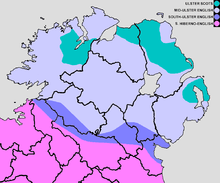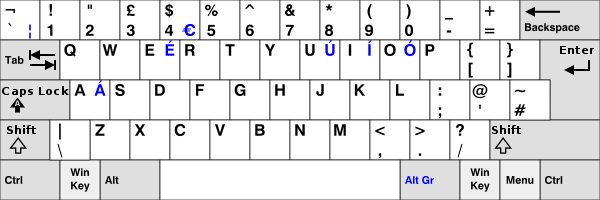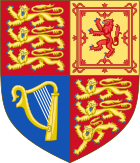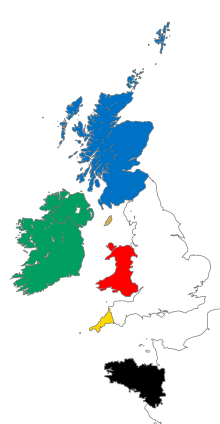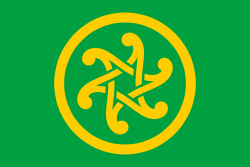Languages of Northern Ireland
English is the most spoken language in Northern Ireland. There are also two recognised regional languages in Northern Ireland: the Irish language (see Irish language in Northern Ireland) and the local variety of Scots known as Ulster Scots.[4] Northern Ireland Sign Language and Irish Sign Language have been recognised since 29 March 2004.[5][6]
| Languages of Northern Ireland | |
|---|---|
| Main | English (99.2%)[1] |
| Minority | Irish (11%),[2] Ulster-Scots (2.0%)[3] |
| Immigrant | Polish (1%) |
| Signed | Northern Ireland Sign Language |
| Keyboard layout | |
| Part of a series on the |
| Culture of Northern Ireland |
|---|
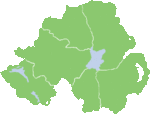 |
| History |
| People |
| Languages |
| Traditions |
|
Mythology and folklore
|
| Cuisine |
| Festivals |
| Religion |
| Literature |
|
Music and performing arts
|
|
| Sport |
|
Monuments
|
|
Symbols |
|
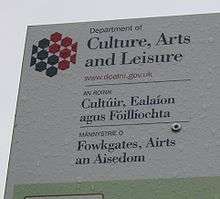
English is spoken as a first language by almost all of the Northern Ireland population. It is the de facto official language and the Administration of Justice (Language) Act (Ireland) 1737 prohibits the use of languages other than English in legal proceedings.
Under the Good Friday Agreement, Irish and Ulster Scots (an Ulster dialect of the Scots language, sometimes known as Ullans), are recognised as "part of the cultural wealth of Northern Ireland".[7] Two all-island bodies for the promotion of these were created under the Agreement: Foras na Gaeilge, which promotes the Irish language, and the Ulster Scots Agency, which promotes the Ulster Scots dialect and culture. These operate separately under the aegis of the North/South Language Body, which reports to the North/South Ministerial Council.
The British government in 2001 ratified the European Charter for Regional or Minority Languages. Irish (in Northern Ireland) was specified under Part III of the Charter, with a range of specific undertakings in relation to education, translation of statutes, interaction with public authorities, the use of placenames, media access, support for cultural activities and other matters. A lower level of recognition was accorded to Ulster Scots, under Part II of the Charter.[8]
The earliest linguistic records from what is now Northern Ireland are of Primitive Irish, from about the 5th century AD. Languages spoken in Iron Age Ireland before then are now irretrievable, although there are some claims of traces in toponymy, including in Northern Ireland.[9]
Shelta, a mixed language spoken by Irish Travellers, is also native to Ireland.
English
The dialect of English spoken in Northern Ireland shows influence from the lowland Scots language.[10] There are supposedly some minute differences in pronunciation between Protestants and Catholics, the best known of which is the name of the letter h, which Protestants tend to pronounce as "aitch", as in British English, and Catholics tend to pronounce as "haitch", as in Hiberno-English. However, geography is a much more important determinant of dialect than religious background.
Irish
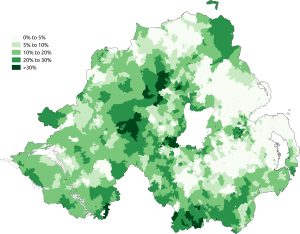
The Irish language (Irish: an Ghaeilge), or Gaelic, is a native language of the island of Ireland.[11] It was spoken predominantly throughout what is now Northern Ireland before the Ulster Plantations in the 17th century and most place names in Northern Ireland are anglicised versions of a Gaelic name. Today, the language is associated with Irish nationalism (and thus with the Catholic community). However, in the 19th century, the language was seen as a common heritage, with Ulster Protestants playing a leading role in the Gaelic revival.
In the 2011 census, 11% of the population of Northern Ireland claimed "some knowledge of Irish"[12] and 3.7% reported being able to "speak, read, write and understand" Irish.[12] In another survey, from 1999, 1% of respondents said they spoke it as their main language at home.[13]
The dialect spoken in Northern Ireland, Ulster Irish or Donegal Irish,[14] is the one closest to Scottish Gaelic (which developed into a separate language from Irish Gaelic in the 17th century). Some words and phrases are shared with Scots Gaelic, and the dialects of east Ulster – those of Rathlin Island and the Glens of Antrim – were very similar to the dialect of Argyll, one of the parts of Scotland nearest to Northern Ireland.
Use of the Irish language in Northern Ireland today is politically sensitive. The erection by some district councils of bilingual street names in both English and Irish,[15] invariably in predominantly nationalist districts, is resisted by unionists who claim that it creates a "chill factor" and thus harms community relationships. Efforts by members of the Northern Ireland Assembly to legislate for some official uses of the language have failed to achieve the required cross-community support, and the UK government has declined to legislate.
Ulster Scots
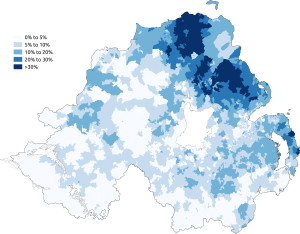
Ulster Scots comprises varieties of the Scots language spoken in Northern Ireland. For a native English speaker, "[Ulster Scots] is comparatively accessible, and even at its most intense can be understood fairly easily with the help of a glossary."[16]
Along with the Irish language, the Good Friday Agreement recognised the dialect as part of Northern Ireland's unique culture and the St Andrews Agreement recognised the need to "enhance and develop the Ulster Scots language, heritage and culture".[17]
Approximately 2% of the population claim to speak Ulster Scots.[18] The number speaking it as their main language in their home is low,[13] with only 0.9% of 2011 census respondents claiming to be able to speak, read, write and understand Ulster-Scots. 8.1% professed to have "some ability" however.[12]
Sign languages
The most common sign language in Northern Ireland is Northern Ireland Sign Language (NISL). However, since, in the past, Catholic families tended to send their deaf children to schools in Dublin where Irish Sign Language (ISL) is commonly used. ISL is still common among many older deaf people from Catholic families.
Irish Sign Language (ISL) has some influence from the French family of sign language, which includes American Sign Language (ASL). NISL takes a large component from the British family of sign language (which also includes Auslan) with many borrowings from ASL. It is described as being related to Irish Sign Language at the syntactic level while much of the lexicon is based on British Sign Language (BSL)[19] and American Sign Language.
As of March 2004 the British Government recognises only British Sign Language and Irish Sign Language as the official sign languages used in Northern Ireland.[20][21]
Immigrant languages
At the 2001 census, Chinese was the most widely spoken immigrant language in Northern Ireland, with Arabic and Portuguese also spoken by a significant number of people.[4] However, an influx of people from recent EU accession states significantly increased numbers of speakers of languages from these countries. In the 2011 census, Polish was the most widely spoken immigrant language, followed by Lithuanian.[22]
Extinct languages
None of these languages were spoken by a majority of the population, but are of historical interest, giving loan words to Ulster Scots, Irish and Hiberno-English.
Latin
Latin was introduced by the early Christians by c.500. It remained a church language, but also was the official language after the Norman conquest in 1171. It was used by the Roman Catholic church for services until the Vatican II reforms in 1962–65.
Norman language
Norman settlers introduced the Norman or Anglo-Norman language during the Norman invasion of Ireland of 1169. From it derived "Law French", that continues to be used today for certain legal purposes in both jurisdictions on the island.
References
- Proficiency in English, 2011 census, NINIS. According to the 2011 census, 99.17% (1,721,242) of participants could speak English "well" or "very well". Retrieved 11 July 2015.
- Knowledge of Irish, 2011 census, NINIS. According to the 2011 census, 5.59% of participants could "speak" Irish. Retrieved 11 July 2015.
- Knowledge of Ulster-Scots, 2011 census, NINIS. According to the 2011 census, 1.98% of participants could "speak" Ulster-Scots. Retrieved 11 July 2015.
- "Language/Cultural Diversity: Frequently Asked Questions". Department of Culture, Arts and Leisure. Archived from the original on 2010-12-21. Retrieved 2011-01-31.
- "Sign Language". Department of Culture, Arts and Leisure. Archived from the original on 2011-01-09. Retrieved 2011-01-31.
- "Paul Murphy announces recognition for sign language". Northern Ireland Office. 2004-03-30. Archived from the original on 2011-05-20. Retrieved 2011-01-31.
I am pleased to announce formal recognition for both British and Irish Sign Languages in Northern Ireland.
- "The Agreement" (PDF). Archived from the original (PDF) on 2011-10-03. (204 KB)
- "Council of Europe Charter monitoring report, 2010" (PDF). Retrieved 7 August 2013.
- D. Ó Corrain, 'A future for Irish placenames', in: A. Ó Maolfabhail, The placenames of Ireland in the third millennium, Ordnance Survey for the Placenames Commission, Dublin (1992), p. 44.
- Markku Filppula (2005). Dialects across borders. John Benjamins Publishing Co, Amsterdam. p. 90. Retrieved 2 January 2011.
- Ryan, James G. (1997). Irish Records: Sources for Family and Local History. Flyleaf Press. p. 40. ISBN 978-0-916489-76-2.
- "Census Key Stats bulletin" (PDF). NISRA. 2012. Retrieved 11 December 2012.
- Northern Ireland LIFE & TIMES Survey: What is the main language spoken in your own home?
- "Frequently-Asked Questions about the Irish Language". Ultach. Archived from the original on 16 April 2009. Retrieved 7 February 2012.
- The Local Government (Miscellaneous Provisions) (Northern Ireland) Order 1995 (No. 759 (N.I. 5))
- Aodan Mac Poilin, 1999, "Language, Identity and Politics in Northern Ireland" in Ulster Folk Life Vol. 45, 1999
- "St Andrews Agreement" (PDF). Archived from the original (PDF) on 4 November 2006. (131 KB)
- Northern Ireland LIFE & TIMES Survey: Do you yourself speak Ulster-Scots?
- Janzen, Terry (2005). Topics in Signed Language Interpreting: Theory And Practice. Amsterdam: John Benjamins Publishing Company. pp. 256 & 265. ISBN 90-272-1669-X. OCLC 60742155. Retrieved 22 June 2008.
- "Sign Language". Department of Culture, Arts and Leisure. Archived from the original on 9 January 2011. Retrieved 22 June 2008.
- "Paul Murphy announces recognition for sign language". Northern Ireland Office. 30 March 2004. Archived from the original on 20 May 2011. Retrieved 22 June 2008.
I am pleased to announce formal recognition for both British and Irish Sign Languages in Northern Ireland.
- "Northern Ireland Neighbourhood Information Service". Retrieved 7 October 2015.
